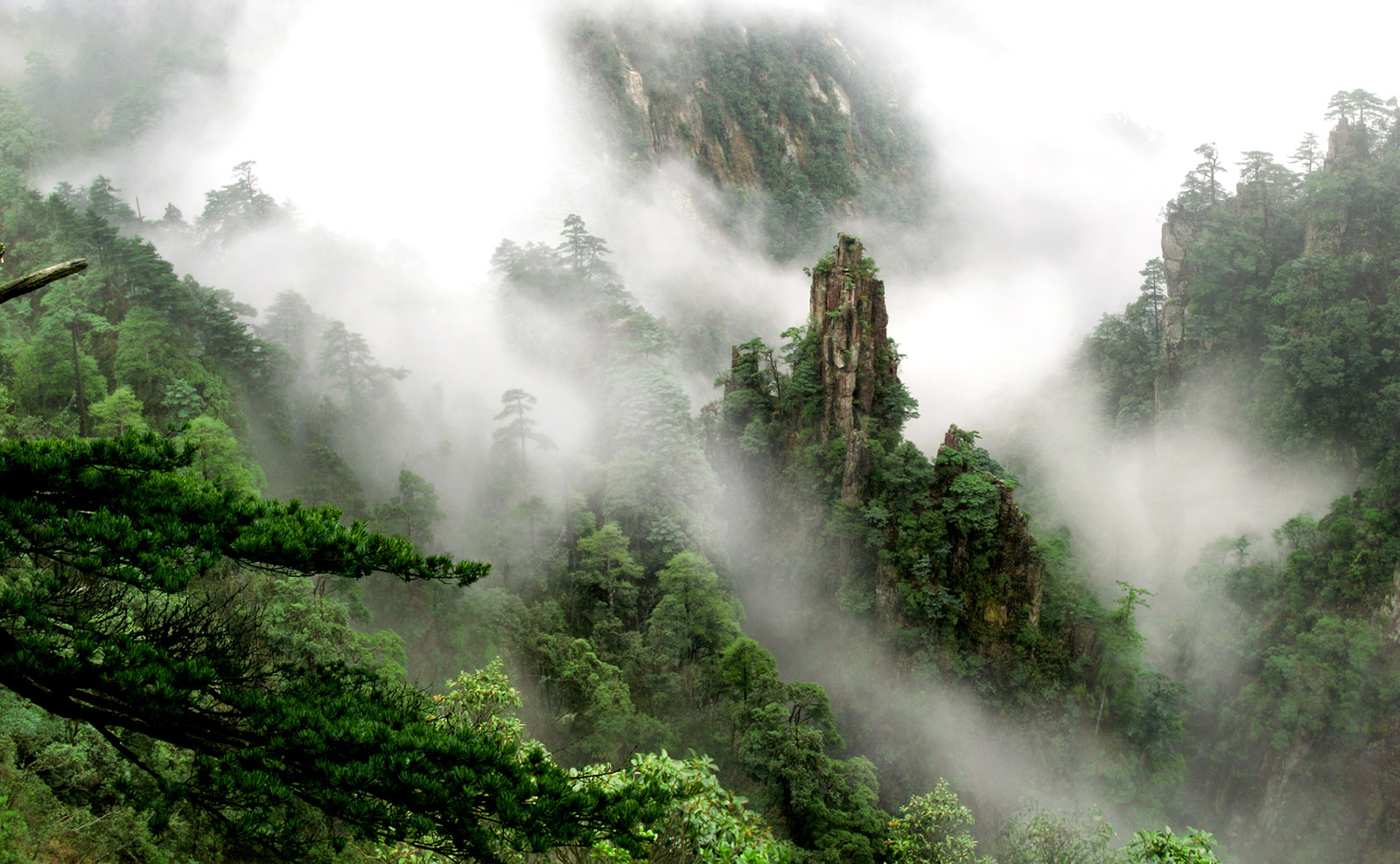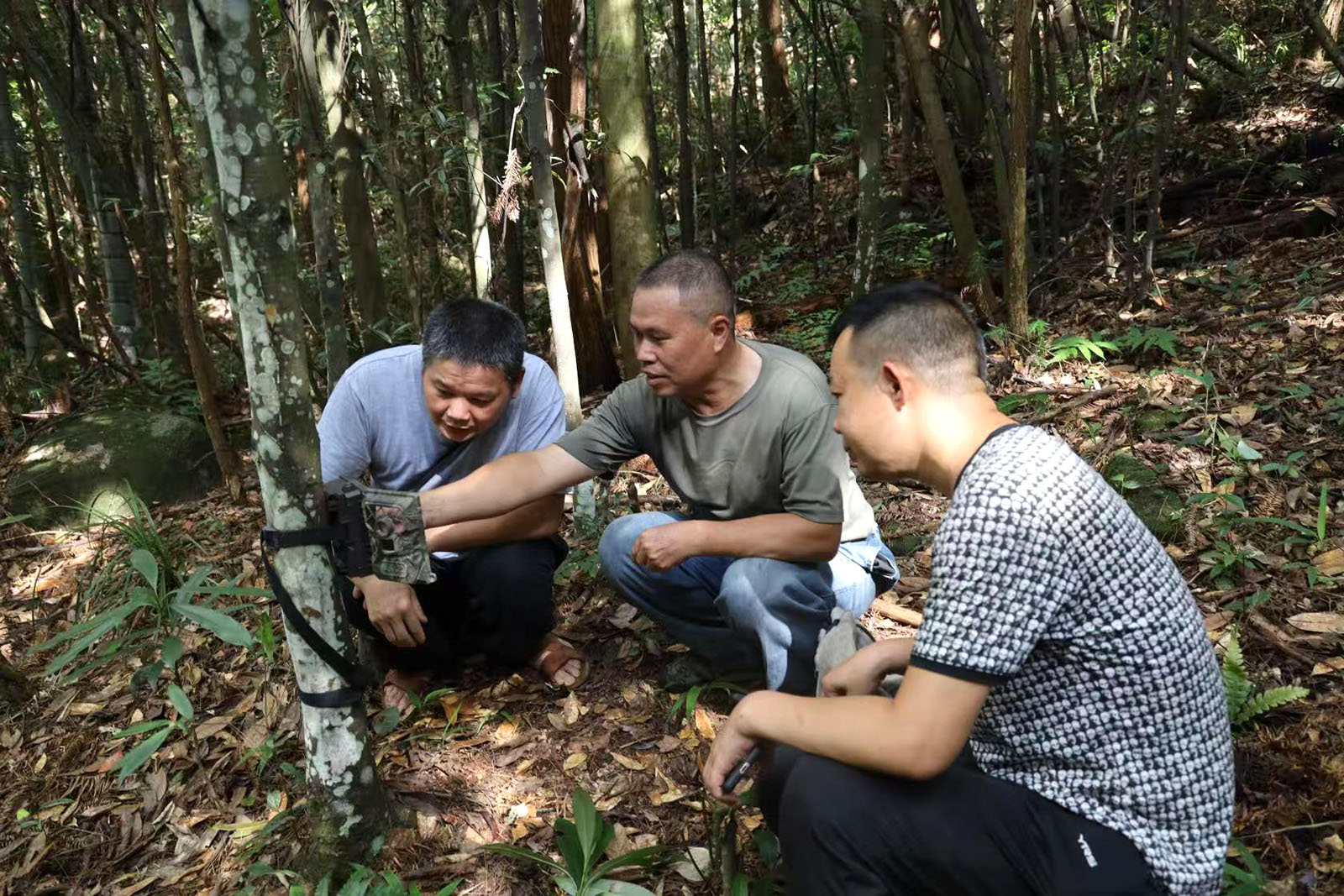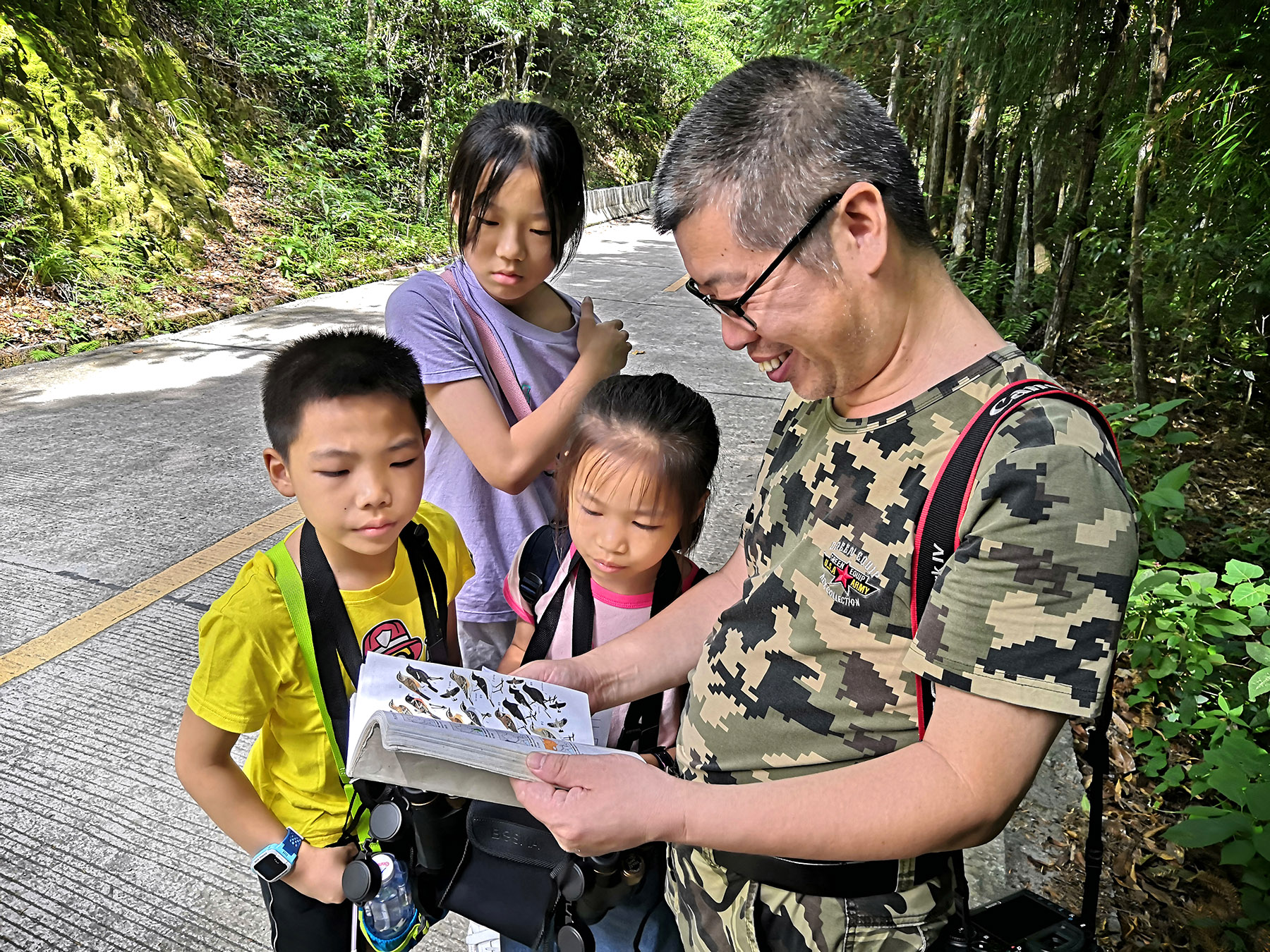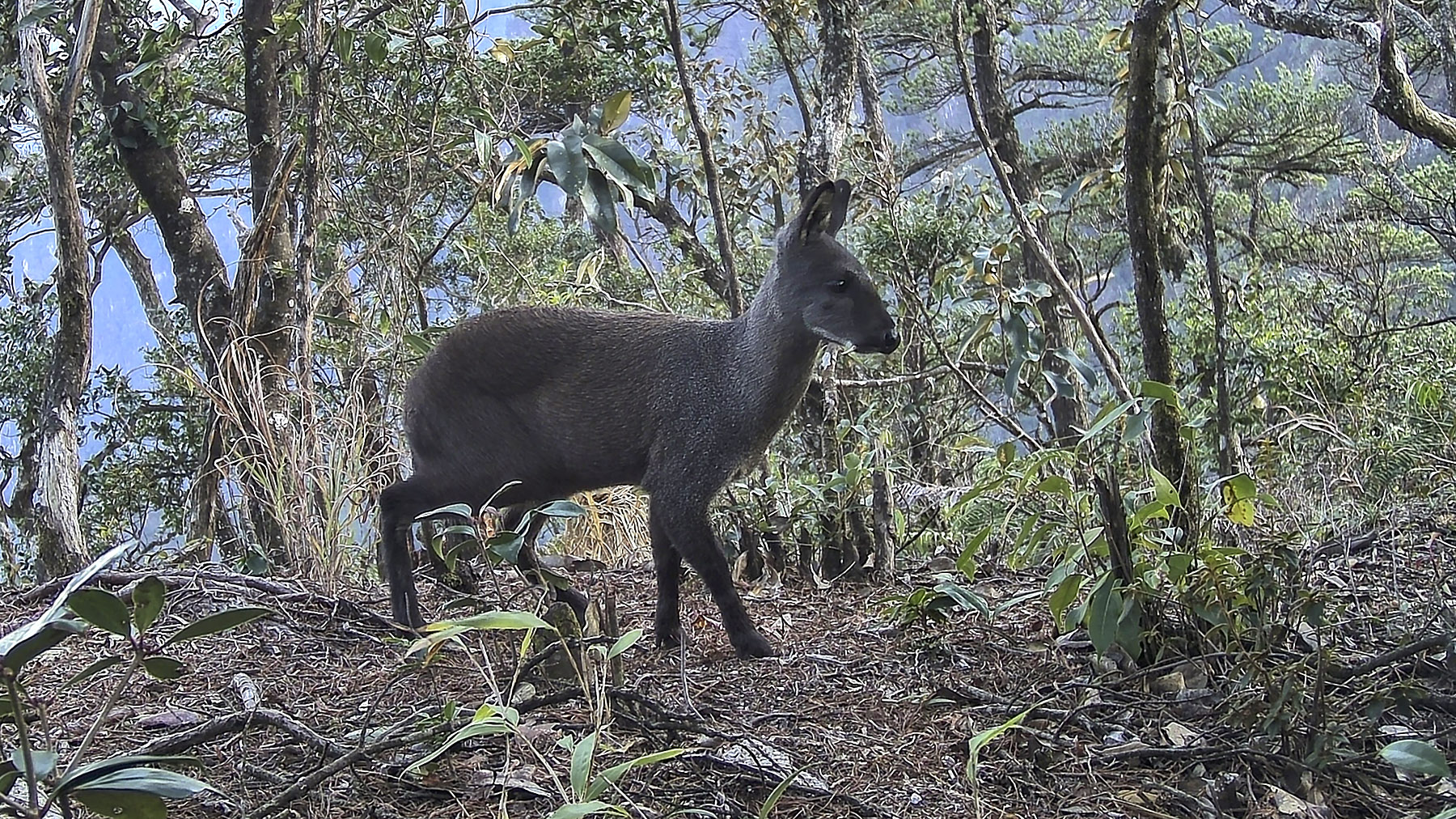Infrared monitors capture footage of elusive musk deer in Hunan reserve

On a morning in May 2020, Chen Desheng, an engineer at the Mangshan National Nature Reserve's science and public education department, was fixated on the computer screen in his office, watching a video clip of a creature with a round, black backside scratching itself against a tree stump without a care in the world.
As the animal turned its head, Chen's eyes widened in surprise.
The creature had a body resembling a small deer, with olive-brown fur, large fluffy ears, a short stubby tail and two tiny tusks protruding from the sides of its mouth.
READ MORE: Oriental storks find shelter in Shandong
"It looks like a forest musk deer!" he thought to himself in astonishment.
Until that moment, the Mangshan reserve had never recorded this endangered and rare species, which is renowned for secreting musk and is classified globally as an endangered species. In 2003, it was upgraded to a first-class national protected animal in China.
The infrared camera was set up by Chen in January of that year and captured five video clips of the animal in February. Chen collected the data in May.

Excited by the discovery, Chen sent the videos to the Hunan Provincial Forestry Department. The experts there were equally thrilled.
"It was lucky to capture footage of a forest musk deer with an infrared camera, but there might be an even bigger surprise," one researcher told Chen.
The forest musk deer found in other parts of the country typically had distinct white or orange patches on their lower jaw, throat, neck and chest. However, the one captured in Mangshan lacked these features, suggesting the possibility of an undiscovered subspecies.
To verify this hypothesis, the Mangshan management bureau dispatched all members of its research personnel to search the mountains for physical traces of the forest musk deer, such as droppings, hoofprints and fur, in hopes of conducting genetic tests.
"Years have passed, and we have yet to find any physical evidence of the animal," Chen told China Daily.
However, infrared cameras scattered throughout the reserve have captured images of the elusive species several more times.
Chen has been a main conductor of the reserve's camera monitoring project. His proficiency in this technique and his deep understanding of the reserve's biodiversity have largely been self-taught over the years. However, he is not the first grassroots conservation expert to emerge from the reserve.

Grassroots expert
Nestled on the northern slope of the Nanling Mountains, spanning Hunan and Guangdong provinces, the Mangshan reserve in Yizhang county was designated as a provincial nature reserve in 1984 and upgraded to a national nature reserve in 1994.
In 1989, Chen Yuanhui, a ranger at the reserve, made a groundbreaking discovery alongside Zhao Ermi, a distinguished herpetologist at the Chinese Academy of Sciences, by identifying the Mangshan pit viper as a distinct species. With a global population of fewer than 500, the viper has become a flagship species for Mangshan.
Due to his dedicated conservation efforts and extensive research on venomous snakes, Chen Yuanhui has become the first and most renowned grassroots expert from the reserve, known as "Dr Snake". In recognition of his contributions, the reserve's management bureau erected a statue in his honor at the Mangshan National Forest Park, a part of the reserve.
Although Chen Yuanhui retired in 2009, his legacy lives on through a new generation of grassroots conservationists in Mangshan, with Chen Desheng among those carrying forward his invaluable work.
When he started working with the Mangshan reserve in 1989, he was a recent college graduate with a degree in metallurgy.
"The reserve's precursor was a forest farm that also housed a metallurgical plant as its production facility," Chen Desheng, 55, told China Daily.
The plant, however, ceased operations in 2003. Following the plant's closure, Chen Desheng was reassigned to the reserve's Xiangsikeng patrol station in 2005. Transitioning into the role of a forest ranger, he assumed responsibilities for conducting daily patrols and monitoring wildlife activities.
"The challenge was there and I had to learn from scratch," he said.
The positive thing is that the reserve, with an area of nearly 20,000 hectares, has long been renowned for its abundant biodiversity, attracting researchers from diverse fields for various surveys.
Often serving as an assistant, Chen Desheng had the invaluable opportunity to learn alongside experts.
He honed his skills in identifying wild plants, amphibians, reptiles and bird-watching, while actively monitoring amphibians with Chen Jun, head of the Xiangsikeng station since 2014.
In 2017, the reserve collaborated with Hunan Normal University to initiate an infrared camera project. Dividing the reserve into over 100 grids, each covering one square kilometer, the project aimed to monitor wildlife inhabiting the area.
Wang Bin, an assistant professor from the university's life science college, and his students guided reserve rangers in setting up infrared cameras across the grids to commence wildlife monitoring.
"At the peak, there were more than 100 infrared cameras working in the wild," Chen Desheng said. "At present, there are about 60 cameras on the mountains."
Chen Desheng, leveraging his engineering background, swiftly mastered camera setup, battery replacement and data retrieval, gradually assuming a pivotal role leading the survey. He shouldered the primary responsibility for fieldwork with the camera.
"That means a lot of hard work," he said.
Every four to five months, accompanied by two patrolmen, Chen Desheng visited each camera site, ensuring its functionality and collecting digital cards.
"We could only visit two remote sites, or four to five nearby sites, in a day," he explained. He needs to visit all of the camera sites at least twice in a year.
In a wildlife and plant identification competition organized by the provincial forestry department for rangers in Hunan, Chen Desheng clinched third prize for the Mangshan reserve. His expertise in camera-trapping surveys led to his transition to the reserve's science and public education department in 2020.

'Dr Bird'
Chen Desheng not only had several good mentors but also a handful of supportive colleagues. One of them is Chen Jun. At the Mangshan reserve, he was known as "Dr Bird".
Born in 1969 at the Mangshan Forest Farm, Chen Jun proudly considers himself a genuine second-generation forester.
In 1990, he graduated from the Hunan Forestry School and returned to work with the Mangshan reserve. Following in the footsteps of his parents, he became a forestry technician.
To transform from a forest farm to a national nature reserve, the Mangshan forestry management bureau collaborated with professors and teachers from several universities in Hunan to undertake a comprehensive scientific survey of the reserve. Chen Jun assisted the experts in their work.
Among these experts was Professor Liao Xiaodong, renowned for integrating ornithology research with promoting bird-watching among the public. Liao became Chen Jun's mentor when he pursued his in-service degree in biology at the Chenzhou Education College, where Liao taught zoology.
The bird survey in Mangshan began in the early spring of 1993.During his studies, Liao mentioned to Chen Jun that Mangshan might be home to Cabot's tragopan, a rare bird under State first-class protection.
On the fourth day of their investigation, a cold front covered Mangshan in snow. Liao and Chen Jun walked in the forest and found a pile of bird feathers. They carefully collected the feathers and hurried back to their base to clean, press and dry them.
After carefully checking the feathers, Liao told Chen Jun that they belonged to a Cabot's tragopan. Mangshan was indeed home to this endangered bird.
Over three years, they braved the elements and ventured through Mangshan's dense forests to gather extensive data and compile surveys. On April 5, 1994, the State Council, China's Cabinet, approved the upgrade of Mangshan to a national nature reserve.
"Learning to watch birds is like having a ticket to nature's theater," Liao told Chen Jun.
Over the years, Chen Jun has acquired in-depth knowledge of the birds inhabiting the reserve, being able to identify them simply by listening to their songs.
Before he was promoted to lead the Xiangsikeng Patrol Station in 2009, he had served as one of the reserve's guides for six years, introducing the reserve's rich biodiversity, especially its avian life, to visitors.
At Xiangsikeng, Chen Jun collaborated with Chen Desheng. In 2014, they established 10 line transects spanning two to three kilometers each to conduct surveys and monitor the reserve's amphibians and reptiles.
ALSO READ: River receiving pristine protection
"To locate amphibians, we often had to venture out at night and wade through streams. It was challenging," Chen Jun said.
Unfortunately, he had to halt the monitoring in 2020 due to vertigo, with family members advising him against leaving the house at night.
"Desheng was eager to continue the work," Chen Jun said. "But I didn't permit him to do so, because it was dangerous for anyone to explore the wildness alone."
He was promoted to lead the reserve's science and public education department in 2019.
As Chen Jun contemplated the future, a sense of unease crept over him. "Desheng and I are getting old," he said. "In order to sustain our efforts, we need new blood to join our cause."
Contact the writer at chenliang@chinadaily.com.cn


